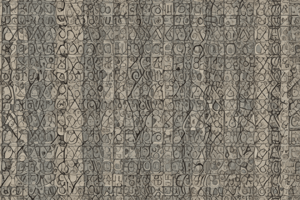Podcast
Questions and Answers
What is the main difference between a sequence and a series?
What is the main difference between a sequence and a series?
- A series is a geometric figure, while a sequence is a numerical computation.
- A sequence is a list of numbers, while a series is the sum of the numbers in a sequence. (correct)
- A sequence is always an arithmetic progression, while a series cannot be.
- A sequence can never be infinite, but a series can be.
Which of the following best describes an arithmetic sequence?
Which of the following best describes an arithmetic sequence?
- The terms are generated by adding a constant to the previous term's square.
- The difference between successive terms is constant. (correct)
- The ratio between successive terms is constant.
- The terms are derived from taking the square of integers.
If the first term of a geometric sequence is 2 and the common ratio is 3, what is the third term?
If the first term of a geometric sequence is 2 and the common ratio is 3, what is the third term?
- 54
- 6
- 18 (correct)
- 162
Which formula represents the nth term of a geometric series with first term 'a' and common ratio 'r'?
Which formula represents the nth term of a geometric series with first term 'a' and common ratio 'r'?
What is an example of a converging series?
What is an example of a converging series?
Flashcards
What is a sequence?
What is a sequence?
A sequence is an ordered list of numbers.
What is a series?
What is a series?
A series is the sum of the terms in a sequence.
What is a term in a sequence?
What is a term in a sequence?
Each number in a sequence is called a term. The first term is denoted by a1, the second by a2, and so on.
What is an arithmetic sequence?
What is an arithmetic sequence?
Signup and view all the flashcards
What is a geometric sequence?
What is a geometric sequence?
Signup and view all the flashcards
Study Notes
Sequences
- A sequence is an ordered list of numbers, called terms, that follow a specific pattern or rule.
- Sequences can be finite (having a limited number of terms) or infinite (continuing indefinitely).
- The terms of a sequence are usually denoted by a subscript, for example, $a_1, a_2, a_3, ...$ representing the first, second, third, and so on, terms.
- Sequences can be defined explicitly, meaning there's a formula to calculate any term directly from its position. For example, $a_n = 2n + 1$, which gives the nth term as an expression of $n$.
- Alternatively, a sequence can be defined recursively, which involves stating the first term and relating subsequent terms to previous ones. For example, $a_1 = 1, a_{n+1} = a_n + 2$, for $n \ge 1$.
Arithmetic Sequences
- An arithmetic sequence is a sequence where the difference between consecutive terms is constant.
- This constant difference is called the common difference, often denoted by 'd'.
- The general form of an arithmetic sequence is $a_n = a_1 + (n-1)d$, where $a_1$ is the first term.
- Examples include 2, 5, 8, 11, ... (common difference is 3)
- Recognizing this pattern helps to quickly identify an arithmetic sequence.
Geometric Sequences
- A geometric sequence is a sequence where each term after the first is found by multiplying the previous one by a fixed non-zero number.
- This fixed number is called the common ratio, often denoted by 'r'.
- The general form is $a_n = a_1 \times r^{n-1}$, where $a_1$ is the first term.
- Examples include 2, 6, 18, 54, ... (common ratio is 3)
- The common ratio is calculated by dividing any term by the previous term.
Series
- A series is the sum of the terms in a sequence.
- Finite series are sums of a fixed number of terms.
- Infinite series are sums of infinitely many terms.
- The sum of the first n terms of a series is often denoted by $S_n$.
Arithmetic Series
- An arithmetic series is the sum of an arithmetic sequence.
- The sum of the first 'n' terms of an arithmetic series can be calculated using the formula $S_n = \frac{n}{2}(a_1 + a_n)$, where $a_1$ is the first term, and $a_n$ is the nth term. Alternatively, $S_n = \frac{n}{2}(2a_1 + (n-1)d)$.
Geometric Series
- A geometric series is the sum of a geometric sequence.
- The sum of the first 'n' terms of a geometric series is given by the formula $S_n = \frac{a_1 (1 - r^n)}{1 - r}$, where $a_1$ is the first term, and 'r' is the common ratio (assuming r ≠ 1).
Finite Series
- For finite series, the sum can be explicitly calculated by adding the terms.
Infinite Series
- An infinite series can converge (have a finite sum) or diverge (have an infinite or undefined sum).
- Convergence is determined by the value of the common ratio 'r' in geometric sequences.
Convergence of Geometric Series
- An infinite geometric series converges if and only if $|r| < 1$.
- The sum of an infinite convergent geometric series is given by $S = \frac{a_1}{1 - r}$.
Sigma Notation
- Sigma notation is a concise way to represent a series. It uses the Greek capital letter 'Σ' to represent summation.
- For example, $\sum_{i=1}^{n} a_i$ represents the sum of the terms $a_1, a_2, ..., a_n$.
Applications
- Sequences and series have wide applications in various fields, including finance (calculating compound interest), physics (modeling oscillations), and computer science (generating patterns).
Studying That Suits You
Use AI to generate personalized quizzes and flashcards to suit your learning preferences.




